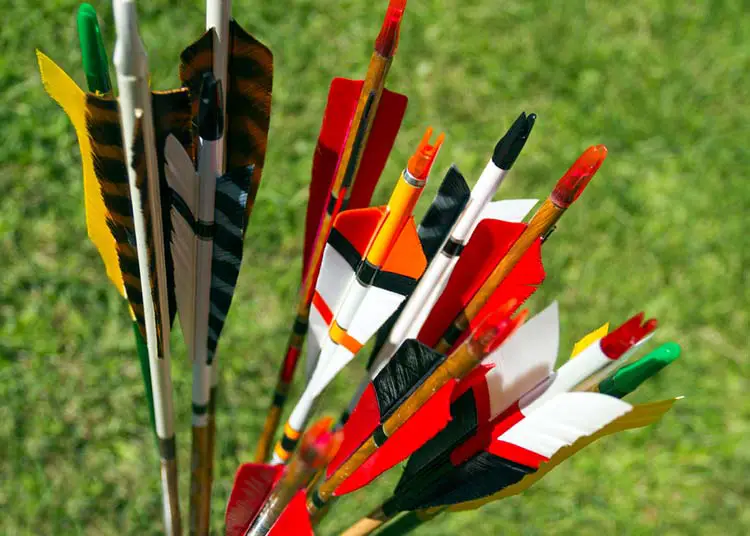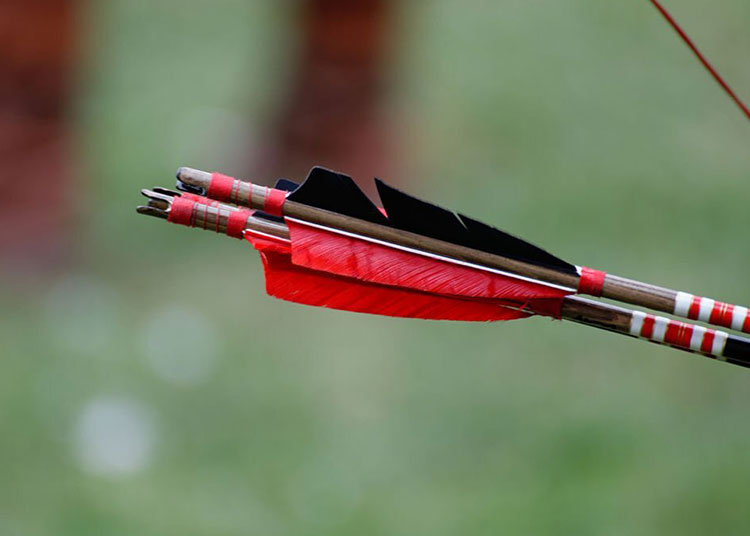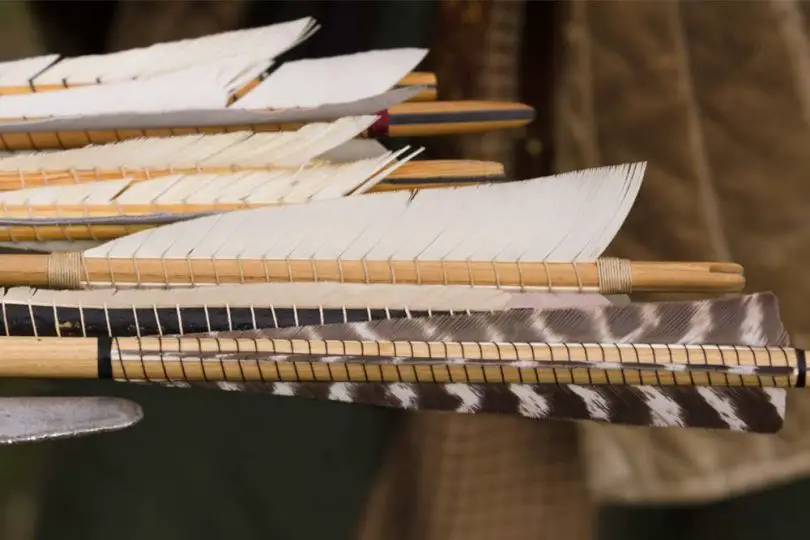Are you an archer looking to perfect your aim? Fletching is the answer! It helps to ensure that your arrow flies true and straight. In this guide, we’ll show you how to fletch arrows and provide you with all the information you need to know, from the types of fletching to the materials you can use. So, sharpen your skills and get ready for success – let’s get fletching!
What Is Fletching?
Fletching refers to the process of attaching feathers or synthetic vanes onto the shaft of an arrow. The primary function of fletching is to stabilize the arrow during flight, which influences both the accuracy and range of the shot. Fletching has been around for centuries and has undergone significant changes in materials and design.
Types of Fletching

There are generally three types of fletching. Each of which provides different levels of stability and spin to your arrows..
There are three types of fletching:
- Straight fletching – This fletching has no angle, and offers minimal stabilization.
- Offset fletching – Offset fletching has a slight angle, and helps reduce spin.
- Helical fletching – Finally, the helical fletching boasts a remarkable inclination that grants peak stabilization and enhances its spin.
When choosing between types of fletching, consider the following:
- For precision hitting or reaching out to faraway targets, the classic straight fletching is the ideal choice.
- Offset fletching should be a splendid pick if you intend to go hunting or shooting in gusty circumstances.
- Helical fletching is best for shooting with a recurve or compound bow.
Fletching Materials
Before learning how to fletch arrows, you should learn some things about the fletching materials. When picking out fletching materials for your arrows, there are several options available to you that you can consider.
Feathers: For centuries, feathers have graced the traditional arrows of many a skilled marksman. These natural wonders are plucked from the feathers of turkeys, geese, and ducks. They are feather-light (pun intended), quite limber, and can withstand a lot in flight, providing that essential arrow stability.
Vanes: For a more modern take, vanes crafted from plastic or rubber are a great option, as they offer enhanced durability and a greater degree of consistency in terms of shape and size.
Other Materials: There are also fletchings available made from other materials, such as synthetic feathers or fur. Some archers may go for that.
When selecting your fletching materials, consider the following:
- If you are seeking a touch of classic experience during your archery and hunting endeavors, then feathers are the perfect pick. For those with more contemporary aspirations and a love for competition, vanes make for an undoubtedly exceptional selection.
- The luxuriousness of feathers makes them a preferable choice for shooting heavier bows, as they are able to provide more cushioning and absorb more of the impact.
- Vanes are far more dependable and robust, a perfect choice when shooting in damp or blustery environments.
Tools and Materials
To fletch arrows, you’ll need the following tools and materials:
- Fletching jig – You can use arrow fletching jig to hold the fletching and arrow shaft in place while you glue them together.
- Glue – For a firm, lasting attachment between your fletching and shaft, a glue specifically designed for archery is your best bet.
- Scissors – You will need sharp scissors for cutting the fletching material to size.
- Arrows – A perfect selection of arrows, tailored to fit your bow for exquisite accuracy.
- Fletching material – Choose feathers, vanes, or other materials that are ideally suited to your arrows in terms of size and shape.
When selecting your tools and materials, consider the quality and durability of each item. Cheap or low-quality materials can affect the accuracy and consistency of your arrows.
Preparation
Before you start learning how to fletch an arrow, you need to prepare your arrows and fletching materials:
Preparing the Arrows
- Clean the arrows – Gently wipe away any dirt or residue from the shafts with a soft cloth to ensure that the fletching adheres securely.
- Determine the nock orientation – Determine the orientation of the nock by placing it in the bowstring and pulling it back. The nock should be perpendicular to the bowstring and oriented with the cock feather or vane facing away from the bow.
- Mark the placement of the fletching – Utilize a marking tool to indicate the precise placement of the fletching on the arrow shaft. It is imperative to uphold a consistent distance between the nock and the fletching for each and every arrow.
Fletching Preparation
- Cutting the fletching – You need to cut the fletching to the right size. Use sharp scissors to do so. Think about the type of fletching and the size of your arrows when you decide how long to cut it.
- Shape the fletching – To make good arrows, you have to shape the feathers just right. You can use a feather cutter or a sharp blade to help us do it easily.
How To Fletch Arrows

Now that you have everything prepared, it’s time to fletch your arrows. Here are the steps:
- Set up your fletching jig in accordance with the manufacturer’s guidelines
- Tenderly place a dab of adhesive at the foundation of the feather and gently nestle it onto the jig. It is crucial that the base of the fletching sits perfectly aligned with the jig.
- Insert your arrow shaft into the jig with the utmost care. Make sure it aligns with the fletching.
- Grace the unveiled side of the fletching with a coat of adhesive.
- Press down firmly on the jig and maintain the pressure for a short time to establish a sturdy connection..
- Continue the same steps for the remaining fletchings by rotating the jig to ensure proper alignment on each arrow.
Finishing Touches
Once you’ve fletched your arrows, you’ll need to do a few finishing touches:
- Trim the fletching – Use sharp scissors to get rid of the excess fletching material from the shaft. Be careful while doing so. You don’t want to trim too near to the base of the fletching.
- Let the glue set – After you have applied the glue to the fletching of your arrows, wait an entire day or 24 hours before using it. This allows the glue to make a strong bond between the fletching and the arrow shaft.
- Inspect the alignment – Examine the alignment of the fletching to ensure that it is straight and pointing the appropriate way.
Troubleshooting
If you’re having issues with your fletching, consider the following:
- Uneven fletching – If the fletchings are not aligned correctly, your arrows may not fly straight. To ensure your fletching jig is aligned properly, and each arrow receives equal pressure, take the time to check them before firing.
- Glue issues – If you are having trouble with your fletching not adhering to the arrow’s shaft, it may be necessary to try different types of glue or to ensure that you are applying an adequate amount of glue to the fletching.
- Incorrect orientation – Find the perfect arrangement for your feather vanes that aligns with your specific bow and shooting technique, to ensure your arrows fly smoothly and gracefully through the air.
Conclusion
If you want to be good at archery, knowing how to fletch your arrows is key. Fletching helps you shoot more accurately and consistently. This guide gives you step-by-step instructions so you can fletch your arrows confidently and precisely. Make sure you use the right materials, prepare your arrows properly, and take your time to stick the fletching to the arrow really well. With practice, you’ll be pro-level in no time.









Leave a Comment